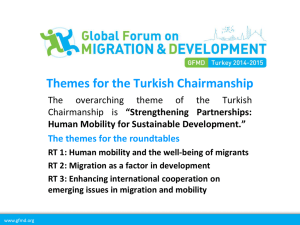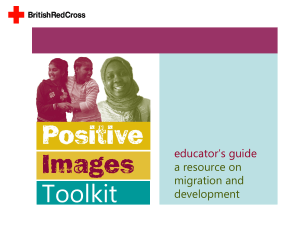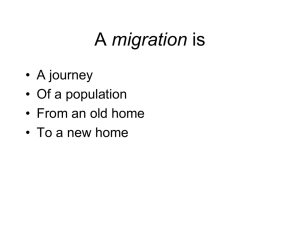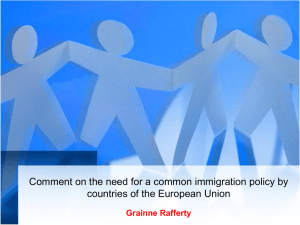Mobility, Migration, Development and Environment International
advertisement
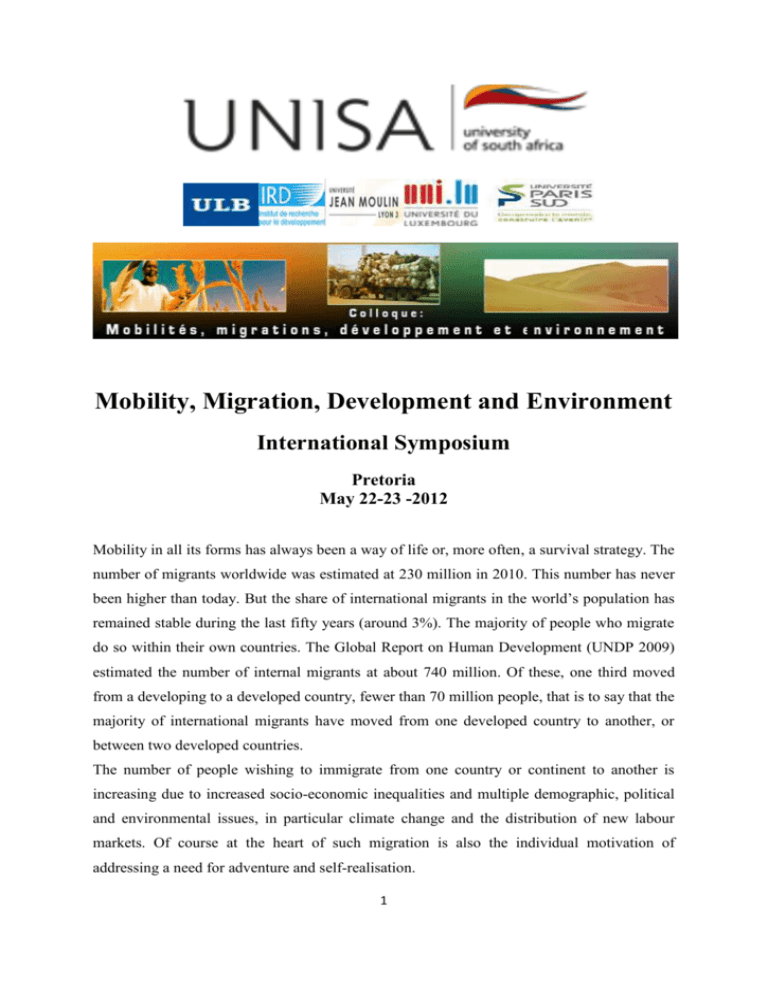
Mobility, Migration, Development and Environment International Symposium Pretoria May 22-23 -2012 Mobility in all its forms has always been a way of life or, more often, a survival strategy. The number of migrants worldwide was estimated at 230 million in 2010. This number has never been higher than today. But the share of international migrants in the world’s population has remained stable during the last fifty years (around 3%). The majority of people who migrate do so within their own countries. The Global Report on Human Development (UNDP 2009) estimated the number of internal migrants at about 740 million. Of these, one third moved from a developing to a developed country, fewer than 70 million people, that is to say that the majority of international migrants have moved from one developed country to another, or between two developed countries. The number of people wishing to immigrate from one country or continent to another is increasing due to increased socio-economic inequalities and multiple demographic, political and environmental issues, in particular climate change and the distribution of new labour markets. Of course at the heart of such migration is also the individual motivation of addressing a need for adventure and self-realisation. 1 - Mobility – an issue of political debate and development Migration is not just a political matter of host countries. The relationship between migration and development is at the core of the development aid debate. Remittances from migrants are higher than official development assistance. Issues like the link between migrations, trade and investment, and the brain drain have become controversial in the context of globalisation. Thus, questions are now being asked about what policies should be implemented to render the impact of these flows favourable to both the countries of origin and the host countries. - Determinants of mobility and its processes Population mobility can be analysed globally, regionally or nationally. In the developing world, movement between rural and urban areas increases as urbanisation grows, forming vast megalopolis. In 2020, most Asians will be living in cities as will Africans. This mobility disrupts economic and demographic balance in terms of migrant and immigrant population flows, and also in terms of private capital, public expenditures, and urban management. Mobility is a solution used, often forced, by individuals to remove obstacles and deal with lack of income, weak purchasing power, job insecurity, difficult access to education and training, medication, proper health care systems and/or the right to free expression. Thus, the decision to migrate is usually caused by a combination of attraction and repulsion: economic, social, cultural and environmental. But while it has never been easier for a small part of the global population to go anywhere in the world, migrations are becoming risky and more challenging for many. On the one hand an analysis of the determinants of mobility, describes, measures, and explains the movement of people in terms of income pursuit and environmental constraints on national or regional political crises. On the other, another analysis focuses on the process arising from these movements: restructuring of labour markets, re-construction of identities of migrants and societies, dietary patterns, status and conditions of life. This interaction and mobility has become a major factor in the re-construction of identities, lifestyles, values, laws etc … whilst coming into contact with an “otherness”. International migration through the networking of people and places gives rise to the transformation of social and political cultures and economies, and cause companies and individuals to question their future. 2 These changes are visible in both the regions of origin of migrants, which may receive income transfers but suffer the social consequences of these departures, and in the most countries where the immigrants contribute to changing socio-economic configurations. - Mobility: sustainability factor transformation of the system Many socio-fragile ecosystems (traditional production methods, indigenous people, tribal communities…) are unable to maintain their existence on the basis of an autonomous development and rely on human mobility as an essential prerequisite to sustainability. This mobility of men and women not only advances the transfer of goods, services and money, but also extends knowledge and standards. This can either reinforce the sustainability of local systems but can also transform or destroy them. - Mobility as a link between climate change and human rights Global climate change is the cause of seasonal or permanent, domestic and international migration. Even if the distinction between political, economic and environmental refugees is delicate, the intergovernmental Panel on Climate Change states that 150 million people will be “environmental refugees” by 2050 because of global warming and the acceleration of soil erosion and water pollution. The international Organisation of Migration (IOM) predicts the number of environmental migrants to reach 200 million by 2050. In developing countries, the achievement of developmental goals (such as the Millennium Development Gaols 2015) is compromised by a number of economic, political as environmental and ecological factors both internally and at the global level. Every human being depends on the nature and ecological services provided by ecosystems to sustain a decent, safe and healthy life: (Millennium Ecosystem Assessment, 2005 MEA). In recent decades, economic activity has had strong negative impacts on ecosystems (climate change, pollution, erosion, extinction of species…) jeopardizing their ability to meet the growing demands for food, grain energy and water. The ability of nature to provide these essential services decreases. In particular, the vulnerability of the 2 billion of people living in dry lands face the loss of ecosystem services increases. The MEA (2005) distinguishes four categories of services derived from ecosystems: provisioning services, regulating services, cultural services and support services. The 3 assessment states that the worsening scarcity of water in fragile ecosystems can cause ecological deterioration and a precarious livelihood in many developing countries and regions. Forty percent of the world’s land can be classified as arid, with water scarcity limiting the production of food crops and other ecosystem services. The reduction of such services accelerates the vulnerability of these areas. This vicious cycle between desertification and poverty can, however, be broken by mobility and migration. 4 Call for papers: specific topics The Complementary and contradictory approaches to population movements, induced transformations in lifestyles, recurring movements and the developing environmental crisis characterise these old and new mobilities, on which the conference proposes to shed new light. It is intended to clarify theoretical frameworks, methods and tools, to the present case studies, analyse local contexts in their multiple social environmental or institutional dimensions, with a focus on prospective dimensions of reading learns grids and the actors strategic. Papers being called for a need to address developments related to the following issues: Topic 1: Forms of migration and the question of borders During the last century, the number of nation states has quadrupled to around 200, with an associated increase in the the number of borders. At the same time, globalisation brings about a change of borders and their functions. Not only is there a physical elimination of national borders, but also new opportunities with an emphasis on safety and development and the ultimate establishment of new borders, and finally the establishment new boundaries between the “winners” and “losers”. With the notion of borders being questioned, what are the current strategies of migrants (north-north, south-south, and south-north)? Looked at in another way, the border shows, not its function of separation and segregation but one of linking creative distinction in the artistic, culinary, social and other arenas. Call for papers on the following: Rethinking the concepts of mobility, migration and borders in a context of globalisation Old and new forms of migration Migration and borders, a historical perspective, a world without borders? Mobility and travel as lifestyle Migration, views of the North and South; migration and co-development? Migration, culture and creativity: fusion, otherness, difference “transnational communities” Sociological and psychological approach to migration Resistance to migration 5 Topic 2: The effects of migration patterns on living conditions and development Intra-state migration can be suburban, seasonal and regional. Continental migration takes place over longer periods, usually assisted by socio-economic networks that are generally geared to overcome the obstacles limiting the mobility of the low-skilled. Generally, the developmental role of migrants is manifested by a human, economic and cultural drain on the different countries of origin and by a gain for the country of destination. Current debates about the extent and scope of the economic benefits of migration do not take sufficient account of the dynamics of the different areas, factors of inequality determining the mobility and its possible enhancement, the emergence migrant networks, the role of transfer of funds, local financial networks and public investments. Call for papers on the following: Migration, economic growth and development Mobility of populations, reflecting the uneven development, the redistribution of the population and the reconstruction of migratory destinations Mobility, the relationship between population and resources, needs, potentials and the dynamics of differential spaces, development of migration strategies, organizing migrant networks in a globalized labour market Migrants, drivers of development, migrant savings in high demand; return of migrants, myth or reality?; migrations and the social balance in the country of origin Does human development have much to gain from a removal of barriers to migration? Topic 3: Migration and the re-establishment or transformation of vulnerable production systems The aim is to encourage a comparative analysis of dynamic economic, social, ecological and local systems of production (agriculture, agro, pastoral), through their relationship to mobility. In localised systems of production, seasonal mobility has pushed the limits of production by adjusting to structural constraints. Is the situation changing? Call for papers on the following: Challenges of mobility for agricultural and rural development Adjustment of forms of mobility or substantive changes? 6 Topic 4: Climate change and migration The achievement of The Millennium Development Goals (MDGs 2015) is compromised by a number of economic, political, and environmental factors (growing loss of ecological services) both domestically and globally. In recent decades, economic activity has had a strong negative impact on ecosystems (pollution, erosion, extinction of species…) jeopardising their ability to meet the growing demands for food, fibres, energy and water. The ability of nature to provide these essential services is decreasing. In particular, the vulnerability of the 2 billion people living in arid countries are facing an increasing decline in ecosystem services. Various biophysical and socio-economic scenarios feature in international negotiations on climate change thresholds and the consequences of migration. The fierce competition for scarce resources such as land and water is not the only the cause of migration but may also increase as the influx of migrants and refugees continue to put pressure on fragile environments and such rural communities not already under stress. Call for papers on the following: A prospective view of climate change scenarios and their consequences in terms of mobility The scenarios of climate change and international negotiation The process of land grabbing in arid regions and mobility Loss of ecosystem services and mobility Topic 5: Governance of migration: migrants and refugees’ human rights The issue of governance of international migrants arises at national, regional and global level. Its resolution requires better cooperation between states and international organisations, a better appreciation of the links between international migration and development, as well as of matters related to trade, aid, state security, human security and human rights. However, the sovereignty of the nation state is being challenged both from above and below. National legislation concerning ordinary migrant asylum seekers and refugees is one of the major legal issues posed by migration. A comparative approach to the rights of migrants, (applicable at national, regional or international level) as well as their obligations is essential. Regardless of their status, whether single migrants, visitors, residents, applicants for asylum or refugees, as such they have rights and are subject to duties. They are governed by national and/or international law. 7 One group of migrants deserves special attention. These are people who are forced to migrate for various reasons and whose rights are constantly violated as asylum seekers or refugees. The issue of international protection of refugees must be addressed. In some countries, they can become accommodated in a “sheltered place” for people moving within a state of which they are citizens and who thus no longer face discrimination and ill treatment. Call for papers on the following: The strengthening of international governance: coherence, capacity and cooperation of stakeholders Policy on migration: protection of migrants’ rights by national and/or international courts Migration , sovereignty and state responsibility The rights of asylum seekers and refugees under the internal law of states, community law or international law Migration and global citizenship Migration, trade and integration Fight against illegal migration and regional or international cooperation: laws, standards and human rights 8 Organisation Partner Institutions: University Paris –Sud University of South Africa/ Pretoria, Institut des Hautes Etudes du Développement (IHED) de Genève, Institut de Recherches sur le Développement (IRD), Université Libre de Bruxelles, Université Jean Moulin Lyon 3, Université du Luxembourg Steering committee: Andre Thomashausen, University of South Africa/Pretoria Andre Mbata Mangu, University of South Africa/Pretoria Marie Eve Nkongolo, University of South Africa/Pretoria Servious Hungwe, University of South Africa/Pretoria Qasaymeh Khaled, University of South Africa/Pretoria Gérard Azoulay, Université Paris Sud Véronique Ancey, CIRAD Idrissa Mbow, Université Paris Sud Domoina Ramanantseheno, Université Paris Sud Nama Ouattara, Université Paris Sud Yélibé Desta, Université Paris Sud Scientifique Committe Gérard Azoulay, Université Paris Sud, Collège d’études Internationales, Véronique Ancey, CIRAD, Selmet, Daniel Dormoy, Université Paris Sud, Collège d’études Internationales, Andre Thomashausen, University of South Africa/ Prétoria, Andre Mbata Mangu, University of South Africa/ Prétoria, Jean Luc Dubois, IRD, UR Résiliences, Vincent Chetail, IHED, Programme pour l’Etude des Migrations Globales, Camille Kuyu, Institut universitaire des sciences du développement, Dakar Chantal Crenn, Université Bordeaux 3, Stéphane Doumbé-Billé, Université Jean Moulin Lyon3, Centre de droit international, François Dubuisson, Université Libre de Bruxelles, Centre de droit international. Michèle Baumann, Université du Luxembourg, unite de recherché INSIDE. 9 Papers: Abstracts must meet the thematic axes of the call for papers. They shall be submitted to: Gérard Azoulay: gerard.azoulay@u-psud.fr They must be filed prior to December 15, 2011, in the form of a 300-400 words accompanied by a brief resume. The abstracts are consulted by the Scientific Committee of the Symposium. If accepted, the Scientific Committee will forward his agreement by email to the principal author of the contribution before January 30, 2012. Papers should be sent before March 30, 2012. In order to present their paper to the Symposium, the authors must imperatively register on terms which will be shown to them. Calendar 15th October 2011: launch of the call for papers 15thDecember 2011: deadline for submission of abstracts by speakers together with a form indicating the motivation, relevance and timeliness of the chosen topic. 15thDecember 2011 to 30th January 2012: review, evaluation, decision of acceptance and notification to speakers by the Scientific Council 1stFebruary to March 30th 2012: Submission of full paper by speakers and the complete conference registration form. 22 to the 23 May 2012: International Symposium Website www.momiden-2012.info 10
